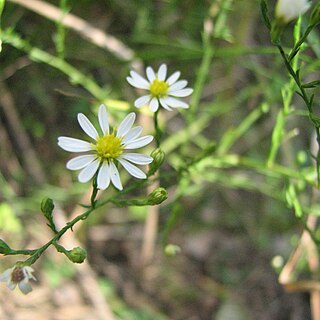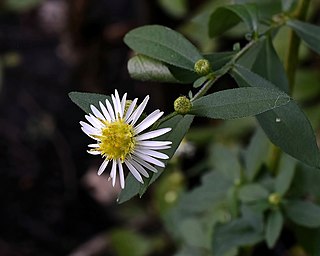Harold Ernest Robinson was an American botanist and entomologist.

Oclemena is a small genus of North American flowering plants in the tribe Astereae within the family Asteraceae.

Symphyotrichum is a genus of over 100 species and naturally occurring hybrids of herbaceous annual and perennial plants in the composite family, Asteraceae, most which were formerly treated within the genus Aster. The majority are endemic to North America, but several also occur in the West Indies, Central and South America, as well as one species in eastern Eurasia. Several species have been introduced to Europe as garden specimens, most notably New England aster and New York aster.

Astereae is a tribe of plants in the family Asteraceae that includes annuals, biennials, perennials, subshrubs, shrubs, and trees. They are found primarily in temperate regions of the world. Plants within the tribe are present nearly worldwide divided into over 250 genera and more than 3,100 species, making it the second-largest tribe in the family behind Senecioneae.

Canadanthus is a North American monotypic genus of flowering plants in the family Asteraceae. The only species is Canadanthus modestus, commonly known as great northern aster or western bog aster. It is native to most of Canada and to northern parts of the United States.
Xylothamia, the desert goldenrods, is a formerly accepted genus of flowering plants in the family Asteraceae. Until 2003, it was held to contain nine species of shrubs native to the deserts of Mexico and the southwestern United States. As of May 2024, Plants of the World Online divided the nine former species of Xylothamia among Aquilula, Gundlachia, and Medranoa.

Symphyotrichum depauperatum, commonly known as serpentine aster or starved aster, is a rare species in the family Asteraceae adapted to serpentine barrens, an ecosystem with a high concentration of toxic metals in the soil. It has been found in Pennsylvania, Maryland, and on some diabase glades in North Carolina. It grows to 50 centimeters and has white ray florets surrounding a center of yellow disk florets.
Welwitschiella is a genus of African plants in the tribe Astereae within the family Asteraceae.
Eurybia horrida is a species of flowering plant in the family Asteraceae known by the common names spiny aster and horrid herrickia. It is native to Colorado and New Mexico in the United States, where it occurs only in the Canadian River basin. It most often included in genus Eurybia.
Guy L. Nesom is an American writer and botanist.

Symphyotrichum dumosum is a species of flowering plant of the family Asteraceae commonly known as rice button aster and bushy aster. It is native to much of eastern and central North America, as well as Haiti and Dominican Republic. It is a perennial, herbaceous plant that may reach a height of 1 meter.

Eurybia glauca is a North American species of flowering plants in the family Asteraceae, called the gray aster. It is native to the western United States, primarily in Arizona, New Mexico, Utah, Colorado, and Wyoming, with a few populations in Idaho and Montana.

Eurybia kingii is a North American species of flowering plants in the family Asteraceae, called the King's serpentweed or King's aster. It has been found only in the State of Utah in the western United States.
Eurybia wasatchensis is a North American species of flowering plants in the family Asteraceae, called the Wasatch aster. It has been found only in the state of Utah in the western United States.

Symphyotrichum urophyllum is a species of flowering plant in the family Asteraceae native to eastern North America, commonly known as arrowleaf aster.

Symphyotrichum ontarionis is a species of flowering plant in the family Asteraceae native to eastern North America. Commonly known as Ontario aster and bottomland aster, it is a perennial, herbaceous plant that may reach heights of 120 centimeters. Each flower head has many tiny florets put together into what appear as one.
John Cameron Semple is a botanist, cytotaxonomist, professor emeritus, and adjunct professor at the University of Waterloo in Ontario, Canada. He was born in Boston and earned a degree of Bachelor of Science in 1969 from Tufts University, followed in 1971 and 1972 by Master of Arts and Doctor of Philosophy degrees from Washington University in St. Louis. Semple is known for his work with members of the tribe Astereae, particularly goldenrods, American asters, and goldenasters, and he maintains the University of Waterloo Astereae Lab website. Semple's wife is Brenda, and in 2013, he named a newly discovered goldenrod species Solidago brendiae in honor of her.

Symphyotrichum racemosum is a species of flowering plant native to parts of the United States and introduced in Canada. It is known as smooth white oldfield aster and small white aster. It is a perennial, herbaceous plant in the family Asteraceae. It is a late-summer and fall blooming flower.

Sanrobertia is a genus of flowering plants within the subtribe Symphyotrichinae of the family Asteraceae. It is monotypic, meaning there is only one species within the genus. Sanrobertia gypsophila is a rare endemic known only from Nuevo León, Mexico.












